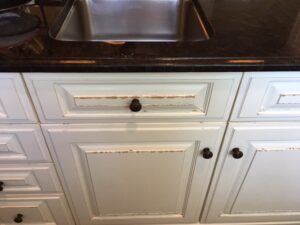Water damage to cabinets is a common issue that can occur in any home, whether due to a leaky pipe, a faulty dishwasher, or a natural disaster. While the initial sight of water-damaged cabinets may be disheartening, the good news is that with the right knowledge and tools, you can often restore them to their former glory. In this comprehensive guide, we’ll walk you through the step-by-step process of fixing water-damaged cabinets, ensuring they regain their functionality and aesthetic appeal.
Assessing the Damage
Before diving into the restoration process, it’s crucial to thoroughly assess the extent of the damage. Identify areas of swelling, discoloration, or warping caused by water exposure. Remove any items stored in the cabinets and inspect the interior for hidden damage. This initial assessment will guide your restoration efforts and help you determine whether repairs are feasible or if replacement is necessary.
Removing Excess Moisture
The key to successful cabinet restoration is ensuring all excess moisture is eliminated. Use towels, sponges, or a wet/dry vacuum to remove standing water. For embedded moisture, employ fans and dehumidifiers to expedite the drying process. It’s crucial to act quickly to prevent the growth of mold and mildew, which can exacerbate the damage and pose health risks.
Disassembling and Cleaning Cabinets
In many cases, disassembling the affected cabinets can facilitate a more thorough cleaning and drying process. Remove doors, shelves, and hardware to access hidden corners and prevent trapped moisture. Clean all components with a mixture of mild soap and water, ensuring any mold or mildew is completely eradicated. Allow all components to air dry completely before proceeding.
Sanding and Smoothing Surfaces
Once the cabinets are dry, carefully inspect for any raised or rough surfaces caused by water damage. Sand down these areas to create a smooth, even surface. Pay attention to any visible discoloration and continue sanding until the wood appears uniform. This step prepares the cabinets for refinishing and ensures a polished final result.
Applying Wood Filler and Patching Veneer
For cabinets with extensive damage, wood filler can be a valuable ally. Apply wood filler to any cracks, holes, or gouges in the wood, smoothing the surface with a putty knife. If your cabinets feature veneer, carefully patch any damaged sections using wood glue and a matching veneer patch. Sand the patched areas once they’re dry for a seamless finish.
Refinishing Cabinets
With the structural repairs complete, it’s time to rejuvenate the appearance of your cabinets. Choose a high-quality wood finish or paint that complements your kitchen’s aesthetic. Apply the finish evenly, following the manufacturer’s instructions. Multiple coats may be necessary for a durable and attractive result. Allow sufficient drying time between each coat.
Replacing Hardware and Reassembling Cabinets
Once the finish is dry, reattach hardware, doors, and shelves. Ensure all components are securely fastened and aligned properly. Take this opportunity to upgrade hardware if desired, giving your cabinets a fresh and modern look.
Preventative Measures for Future Protection
To safeguard your cabinets against future water damage, consider implementing preventative measures. Install water leak detectors near appliances and pipes, regularly inspect plumbing for leaks, and ensure proper ventilation in areas prone to high humidity. Additionally, applying a water-resistant sealant to your cabinets can add an extra layer of protection.
Conclusion
Restoring water damaged cabinets is a challenging but rewarding process that can breathe new life into your kitchen or bathroom. By promptly addressing water damage, thoroughly assessing the extent of the issues, and following a systematic restoration process, you can salvage your cabinets and prevent further deterioration. Remember, patience and attention to detail are key throughout this process, resulting in cabinets that not only regain their functionality but also enhance the overall aesthetic of your living space.
No related posts.
